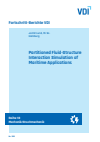Partitioned Fluid-Structure Interaction Simulation of Maritime Applications
Zusammenfassung
In this work, the benefits of employing the partitioned approach in fluid-structure interaction simulations are demonstrated in four different examples: Simulations of a floating offshore wind turbine and a wave energy converter are used to analyze dynamic effects and improve the structural design. A multilayered submersible mixer validates the simulations by assessing local strains, thrust, and torque. Finally, an anisotropic ship propeller made of carbon-reinforced polymer is optimized with an evolutionary algorithm based on coupled simulations concerning efficiency, thrust, and cavitation.
Schlagworte
- Kapitel Ausklappen | EinklappenSeiten
- I–VIII Titelei/Inhaltsverzeichnis I–VIII
- 1–4 1 Introduction 1–4
- 1.1 Motivation
- 1.2 Stateoftheart
- 1.3 Purposeandscopeofthisthesis
- 5–20 2 Structural mechanics 5–20
- 2.1 Balance equations
- 2.2 Constitutive equations
- 2.2.1 Isotropic material modelling
- 2.2.2 Anisotropic material modelling
- 2.3 Weakform
- 2.4 Spatial discretization
- 2.4.1 Shape functions
- 2.4.2 Discretization of the weakform
- 2.5 Temporal discretization
- 2.5.1 Central difference method
- 2.5.2 Newmark method
- 2.5.3 Generalized alpha method
- 2.6 Solution of nonlinear equation systems
- 2.7 Post-processing
- 2.8 Static condensation
- 21–34 3 Fluid mechanics 21–34
- 3.1 Basic equations of fluid mechanics
- 3.1.1 Navier-Stokes equations
- 3.1.2 Potential theory
- 3.2 Finite volume method for the solution of the Navier-Stokes equations
- 3.2.1 Spatial discretization
- 3.2.2 Temporal discretization
- 3.2.3 Velocity-pressure coupling
- 3.3 Boundary element method for the computation of potential flows
- 3.3.1 General formulation
- 3.3.2 Elementary solutions
- 3.3.3 Spatial discretization
- 3.4 Propeller parameters
- 35–48 4 Fluid-structure interaction 35–48
- 4.1 Partitioned solution approach
- 4.2 Extrapolation methods
- 4.3 Interpolation methods
- 4.3.1 Nearest neighbor interpolation
- 4.3.2 Barycentric interpolation
- 4.3.3 Inverse distance weighting
- 4.3.4 Mesh-based interpolation
- 4.4 Convergence criteria
- 4.5 Convergence acceleration methods
- 4.5.1 Static relaxation
- 4.5.2 Aitken method
- 4.5.3 Quasi-Newton methods
- 4.6 Coupling framework comana
- 49–61 5 Floating windturbine 49–61
- 5.1 Introduction
- 5.2 Conceptual design
- 5.3 Simulation setup
- 5.4 Simulation results
- 62–70 6 Wave energy converter 62–70
- 6.1 Conceptual design and experimental measurements
- 6.2 Simulation setup
- 6.3 Simulation results
- 71–80 7 Submersible mixer 71–80
- 7.1 Experimental setup
- 7.2 Simulation setup
- 7.3 Simulation results
- 81–117 8 Ship propeller 81–117
- 8.1 KCS propeller
- 8.1.1 Simulation setup
- 8.1.2 Numerical errors due to rotational movement
- 8.1.3 Stiffness variation
- 8.1.4 Comparison of convergence acceleration methods
- 8.2 Optimized propeller
- 8.2.1 Optimization methods
- 8.2.2 Automatic framework
- 8.2.3 Anisotropic material
- 8.2.4 Parameter study of anisotropic material
- 8.2.5 Ship propeller optimization
- 118–123 9 Summary and outlook 118–123
- A Appendix
- A.1 Ship propeller–simulation results
- 124–138 Bibliography 124–138


